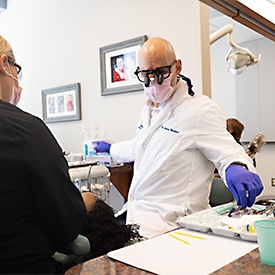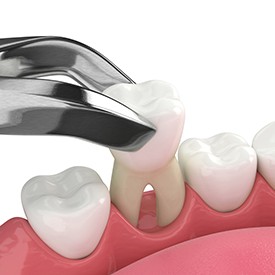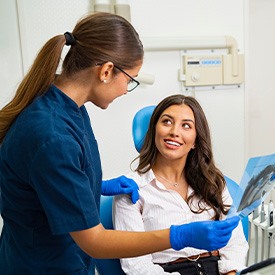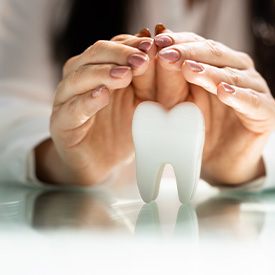 La Plata
La PlataDental
 La Plata
La Plata At La Plata Dental, we do our utmost to help patients keep their natural teeth whole and healthy throughout their lifetime. However, there are cases where even dental crowns, root canals, and other advanced restorations fall short. When this happens, we may have to remove one or more teeth to ensure overall oral health. To find out more about tooth extractions, contact our La Plata dentist and team to schedule an appointment today. You can also read on to learn more!
At La Plata Dental, we do our utmost to help patients keep their natural teeth whole and healthy throughout their lifetime. However, there are cases where even dental crowns, root canals, and other advanced restorations fall short. When this happens, we may have to remove one or more teeth to ensure overall oral health. To find out more about tooth extractions, contact our La Plata dentist and team to schedule an appointment today. You can also read on to learn more!

As we mentioned above, extracting your tooth is never our first suggestion. That said, there are some cases where it’s the only option we’re left with, like when:

Depending on the location, size, and positioning of the tooth, our experienced dentists will recommend either a simple extraction or a surgical extraction. With a simple extraction, we will numb your mouth before gently rocking the tooth in question back and forth until it comes away. Surgical extractions also begin the same way: numbing your mouth. Then, we will cut away some soft tissue, and in some cases, we break the tooth into two or more sections for easy removal.

Tooth extractions are affordable for most patients. When you come in for your restorative dentistry consultation, our team can provide an itemized estimate for your treatment plan. We will also be happy to explain your payment options. For example, we welcome insurance and accept third-party financing through CareCredit. We do not want you to feel overly stressed about paying for your treatment, so do not hesitate to talk to us if you have questions or concerns about the monetary aspect of your care.

Some factors that might have a bearing on the cost of your extraction procedure include:

Very often, yes, dental insurance does cover tooth extractions. Depending on the details of the procedure, it might be classified as a major or minor service, so anywhere from 50% to 80% of its cost might be covered. Our La Plata dental team welcomes insurance, and we are in-network with several popular plans. We will be happy to help you understand how your benefits apply and file claims on your behalf.

Insurance is just one provision that might make it easier to afford your extraction procedure. You may also choose to use financing through CareCredit, a third-party company that specializes in helping patients pay for medical and dental expenses. The application process is very fast, and most patients are quickly approved for a payment plan that works within their budget. Very often, low-interest or no-interest arrangements are available.
Are you eager to learn more about the cost of tooth extractions? Talk to our team today. We will help you navigate every aspect of your care so you can commit to treatment with confidence!

Whether you’re having one tooth extracted or several, there are a few things we recommend doing to prevent complications, like a dry socket, including:
If you have any remaining questions for us about tooth extractions – whether it’s about the procedure or the recovery period – don’t hesitate to reach out to our La Plata dental team. We’d be happy to answer any questions we can over the phone and schedule a consultation for you at our office so you can learn even more.
Once a tooth has been removed, you do have the option of simply leaving the space where it used to be empty. The real question, though, is whether you should. Even if the gap can’t be seen in your smile, it might still negatively impact your life in other ways. For one thing, it could lead to digestion issues by making it more difficult to chew your food properly. Additionally, your other teeth may start to drift toward the open space and become misaligned.
Simply put, it is generally in your best interest to have extracted teeth replaced as promptly as possible. Talk to our team to see what replacement options are available.
Depending on your situation, you may be given specific instructions to follow prior to your tooth extraction. For example, you might be told not to consume anything except water on the morning of the procedure, or you might need to go pick up a prescription. Whatever instructions you receive, it’s best to follow them to the letter; please let us know immediately if there’s anything you don’t understand.
It should be emphasized that tooth extractions are very safe, especially when carried out by an experienced dental professional. That being said, there is a possibility that the extraction site could become infected while your mouth is still healing. Luckily, there are steps you can take to make infections less likely to happen, such as keeping the blood clot safe, rinsing with salt water, and brushing your teeth thoroughly. (Be sure to stay away from the extraction site while you’re brushing.)
Sometimes antibiotics will be prescribed after your tooth extraction, but this isn’t typically necessary for every patient. If you do end up needing antibiotics, be sure to carefully follow the provided directions for taking them.
Despite the concerns of many patients, the extraction process itself is not actually painful, thanks to the use of a local anesthetic. However, it is normal for there to be some soreness afterward. Following your aftercare instructions can help reduce your discomfort while you’re waiting for your mouth to heal. The pain should not get worse over time, so if that happens, call us right away so that we can take steps to figure out what the problem is.
Dentists prefer to save natural teeth whenever possible, which is why a tooth extraction is generally treated as a “last resort” option. If it’s being recommended in the first place, it’s likely because alternative services have already been ruled out. You can rest assured that our team will always have the best interests of your smile at heart and will only suggest a tooth extraction if we believe it is truly right for you based on your oral health situation.